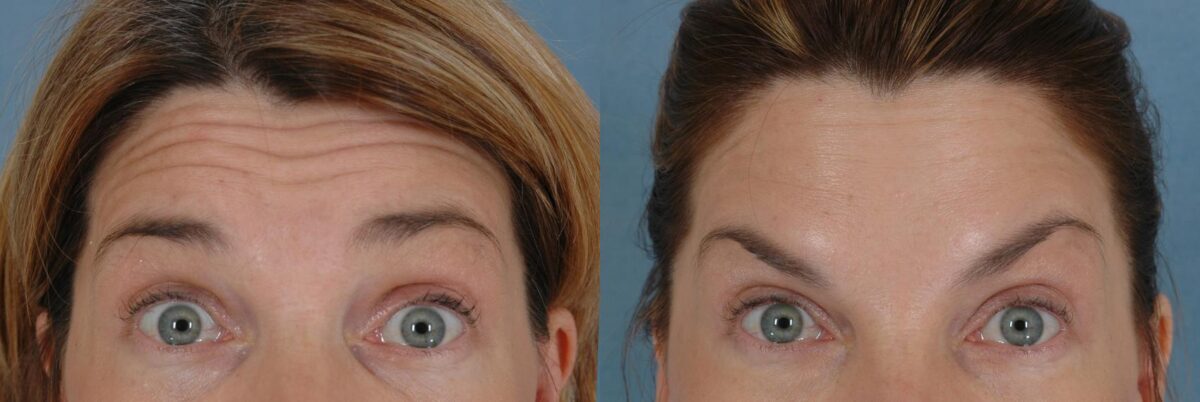Typical Duration of Botox Effects
Unlike surgery, the effects of Botox are not permanent but its greatest advantage is in providing a solution for wrinkles and fine lines. As a rule, the outcomes of the cure are active for three to six months after the treatment with Botox.
In most cases, patients should see some change and fairly marked improvement within 2-3 days after the injection, with the magnitude of enhancement reaching its peak 10-14 days after the treatment. At this time, the muscles that were targeted are tense-less, hence decreasing the effect of dynamic wrinkles, which have been brought about by movements like frowning or squinting.
Factors Influencing Botox Longevity
Several factors can influence how long Botox’s effects last. These include:
Dosage and Injection Technique:
It is essential to note that the quantity of Botox injected and the ability of the specialist influence Botox outcomes’ durability. However, the enhancement of botox’s effectiveness and longevity can only be achieved through the right dosage administered through injections.
Metabolism:
People with a higher metabolism rate will also experience a shorter duration of Botox effect. This is because their bodies metabolize the neurotoxin faster than Leshi and others, who also suffered the ill effect of parboiling.
Muscle Activity:
Specifically, areas of the face with more muscle activity may start losing the Botox effects before others. For instance, if the facial muscles of a person who frowns or squints often are targeted, then such a person will not enjoy the solution for as many hours as others.
Frequency of Treatments:
Some clients decide to follow the regular Botox treatment, and they note that its impacts are longer with time. The target muscles are normalized over time, meaning they get less active leading to the lack of frequent and severe wrinkles.
Lifestyle Factors:
Daily activities that degrade skin’s health like smoking, over-exposure to sunny, and high-stress levels can decrease the potential existence of Botox.
Maintaining Botox Results
To prolong the results of Botox, there are several strategies one can employ:
Regular Treatments:
Maintenance is recommended every three to six months; otherwise, the skin may lose the enhanced appearance. In this case, with the progression of the disease and a decrease in the muscles’ strength, the time intervals between the treatments may also increase.
Healthy Lifestyle:
Paying particular attention to leading a healthy lifestyle, shunning the habit of smoking, protecting oneself from the scorching sun, and managing stress goes a long way in helping retain the youthful appearance that Botox offers.
Skincare Routine:
High-quality skincare products should be employed and cosmetic products containing retinoids, hyaluronic acid, and antioxidants should be used to improve skin texture and elasticity to suit combination with Botox.
Hydration and Nutrition:
Recommendations like taking enough water frequent reminders on healthy eating habits, and increased intake of vitamins and minerals help to maintain skin health which may lead to an increase in the duration of botos results.
Signs That Botox Is Wearing Off
As Botox begins to wear off, you will notice a gradual return of muscle activity in the treated areas. Some signs that your Botox is wearing off include:
Gradual Return of Wrinkles:
The deep wrinkles that have been rendered flat by Botox will gradually begin to return to their previous state. You may observe this first of all if for instance when frowning or smiling.
Increased Muscle Movement:
You may notice that certain areas of your body where you applied the Botox may start to move more than they used to, meaning that the Botox is no longer fully paralyzing the muscle.
Diminished Smoothness:
The skin may begin to revert to the look it had before getting Botox treatment; the prevalent fine lines and wrinkles may appear again.
Frequency of Maintenance Treatments
Depending on one’s lifestyle and the extent of the skin problems, many individuals opt for touch-up treatments, with the best three to six months after the initial treatment. However, it is different for each person and depends on the areas treated, the rate of Botox metabolism in a person’s body, and their desires and preferences.
Patients should consult with a healthcare provider who is competent and experienced in the prescription of such treatments and in creating the proper treatment plan. They can also increase or decrease the dosage as well as vary the areas to be injected when planning their next treatment session.

Leave a Reply